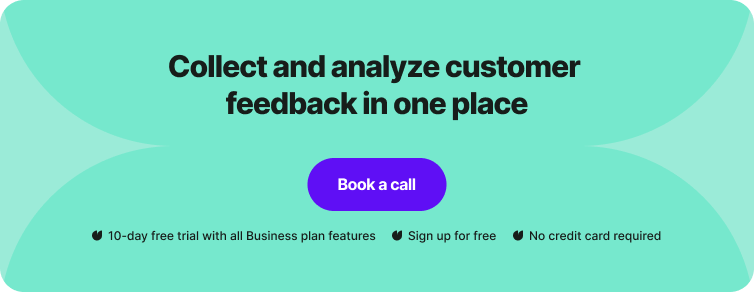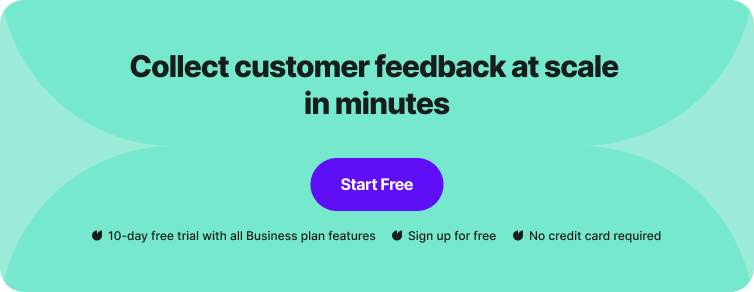It can seem hard to believe but having competitors is a good thing. If you have no competition there is something wrong with your product-market fit.
In that case, you should identify your product-market fit with a customer survey like this one:
If you’re a startup looking for funding, VCs prefer to see a list of your competitors rather than to hear that you’re so innovative you have no competition at all.
At the same time, competition is also a problem – competitors take customers away from you and make customer acquisition trickier. The fact is that your competitors might be better at some business activities and can even cause you to go off the market.
But, tracking their moves can help you compete and find loopholes in their strategy.
Check out our 10 winning techniques to learn how to spy on the competition better.
How to Spy on the Competition - 10 Winning Techniques
1. Subscribe to Newsletter and Social Media
This is where you should start. Follow all competitors you know on social media, sign up for newsletters, and observe their blogs. Companies announce new features, publish product updates and other news that can give you some insight into what they’re doing and what they’re about to do. If you don’t track all your competitors do it now and go back here in a minute.
It turns out that even something as simple as tracking social media activities can be automated and made simpler. Social-searcher shows you all social media activity of any chosen company. Easily check their activities on Twitter, Facebook, Youtube, and more. Discover competitors’ weak sides and don't miss a unique opportunity to turn their failures into your wins. You can monitor all web mentions plus 10 popular social networks for the price of a coffee cup with Social Searcher.
2. Track Brands
Ok, everyone is following competition so let’s move to a bit more advanced form of spying on competition – monitoring brands. The companies show you what they do and what they say but not what people say about them. We’re living in the era of sharing every piece of information and experience so people share their opinions on companies.
The support team failed to solve a problem quickly? You’ll read about it on social media and that’s exactly what you want to know about. Highlight the weaknesses of your competitors as your strengths and think about a marketing campaign that could use it in a clever way.
Immediate response to your competitor’s failure can give you some buzz in media and create a good image of yours. Remember the buzz created by bending iPhone 6 Plus and how it was used by many companies, not only Samsung? Read this article if you don’t. That’s what brand monitoring can help you create.
The basic monitoring can be conducted for free using Google Alerts. You can choose keywords, language, and frequency of updates. The problem is accuracy – even though Google is the king of the internet, their alerts miss a lot of mentions. That’s why you should look for other software if you’re serious about monitoring the brand. Brand24 is a reasonable choice, which offers many advanced features even in the basic plan. Example: you can segment by positive, negative, or neutral mentions. Pricing starts at $49 a month.
3. Find out What Technologies They Use
Sometimes you just know that the competitor is better at something, for example, marketing. You visited their website and they track you everywhere with ads that are so well-tailored you just want to click. They might be the masters of Google Remarketing and Facebook Retargeting but you know it’s something more – you see ads not only from their networks but others as well.
Do they have a team of top-notch marketers who place great ads everywhere? No way, they employ 5 people including 2 interns. There must be some clever software involved. How to check what exactly?
Not a big deal – visit builtwith.com and type in the URL. You will see what technologies the website uses so you can implement it for yourself or look for even better alternatives. Checking technologies on websites is free, more advanced features (importing a list of websites using given technologies) are included in a paid version.
4. Check Popularity
Some companies have thousands of likes on Facebook and followers on Twitter. Does it mean they have many visitors and customers? Not necessarily. It often means they just spend lots of time developing social media presence. More reliable data is needed to figure out how popular your competitors are.
One of the metrics that are easy to check and gives you a lot of information is traffic to the website. Not only numbers are important but also trends – some competitors might be not popular at the moment but traffic growing 50% a month shows that they might kick your ass in a few months.
There are 2 basic tools you should use: Similarweb and Alexa. None of them is 100% reliable, but you can observe trends and have an overall view of their popularity. Similarweb shows you not only the amount of traffic but also its sources so it gives you a hint where it could be worth to advertise or to be present. Both tools are free for basic use and offer more advanced insights in paid plans.

5. Check Paid Keywords
Do you wonder how your competitors acquire customers? I can say with 95% of certainty – they run AdWords. Everyone runs AdWords campaigns. Even Google itself.
Google “AdWords” and check the results if you don’t believe it. Knowing what keywords your competition uses for search engine ads will allow you to estimate costs and find niche keywords that are cheaper. You will also find out how your competitors position themselves on the market.
Typing all existing words into Google to see when ads of your competitors appear would be rather time-consuming and could not give you reliable results (you can be in a location outside of their targeting) so it’s better to use the software.
One of the most powerful tools you can use to spy on your competitors' AdWords is iSpionage. You can get an overview of what keywords they buy, what are their main competitors and what are their landing pages. Pretty useful and for free. More advanced features like exporting lists of keywords are available in subscription plans, which start at $49 a month.
When you know what keywords your competitors but you can find niche keywords and save some money. Probably the best and most popular tool is keywordtool.io. The free version gives you a list of keywords related to the chosen one. Copy and paste this list to AdWords keyword planner and you know the estimated CPC and search volume. Analyzing those numbers can help you discover keywords worth bidding (look for high search volume, low competition, and CPC).
6. Check SEO
Probably you wonder how your competitors acquire so many users. As already mentioned, they probably run AdWords but no one can afford to buy 100% of traffic. The answer is often the same – organic traffic from search engines.
However, even two companies providing very similar products can position themselves on the market in 2 different ways and thus emphasize different keywords.
Similarly to paid keywords, it’s valuable to know what keywords bring organic traffic to the website. You can try to optimize your search engine for similar keywords or try a different strategy.
Positionly is a great tool for spying on your competitors’ keyword rankings. With just a glance, you will be able to see how your website is doing in comparison to other brands. The app gives you real-time data and is invaluable in evaluating the distance that divides you from the industry leaders. Plans start at $19 a month. Startups can apply for a free plan for 6 months.
7. Check Display Ads
The display is a popular and often efficient form of advertising. The problem is that you have to know how to do it – you have to create a nice and effective ad and place it in the right place. Observing what ads your competition is running can help you create your own strategy – you might spot weaknesses in their marketing message or have an idea of where to place them to bring more high-quality traffic. Similarly to monitoring ads in search engines, you are not able to visit all the websites to check where your competitors place their ads so you need a tool.
WhatRunWhere is the premium competitive intelligence service for online advertising and media buying. It gives you an in-depth look into company and brand-level advertisements so that you can learn key elements of your competitors' strategies including where they are advertising geographically, top publishers they are using to serve ads, the duration of their campaigns, creatives being used and promotions being advertised. Not only are you gaining an understanding of their strategies but you can also find untapped opportunities to capitalize on. Pricing starts at $150 a month
8. Check Backlinks
Discovering who’s linking to websites of your competitors can give you a hint of what marketing strategies are working and where it would be great to get featured. A link to your website on a website that is popular among your target audience can give a great boost in the number of visitors and registrations, not to mentions benefits for your SEO efforts. Some tools I already mentioned have this feature, but there are also others specifically for checking backlinks.
Monitor backlinks is meant specifically for that. Monitor Backlinks automatically checks your competitors' backlinks and every 10 days sends a report with all the links they have built or earned recently. You can find new link building opportunities and determine the value of the links using the metrics available.
Some of these metrics include MozRank, Domain Authority, Page Authority, Ahrefs Rank, Number of external links, hosting IP location and link status. You can check the backlinks of your competitors or any other website for free. More advanced features are available in plans, which start at €27,9 a month.

9. Identify Brand Ambassadors
People trust other people, not companies. That’s why it is so important to have people talking about you and recommending you. Companies that were first to the market have it easier – people started using them and tell their friends about it. The problem for market challengers is that people usually stick to the solutions they use.
You have to show them something really great about your product or their current provider must really annoy them in order to convince them to switch. The result is that converting users is not easy but worth the effort – if they say to all their friends and followers that they started using your product and it’s much better than the previous one, it will be even more powerful than their recommendations of the previous solution.
How to spot brand ambassadors? One of the ways is to use the brand monitoring tools mentioned above. But it will be a bit complicated – you will know who is talking about the brand, but you don’t know their influence. You won’t be surprised that there are tools that can do that. Moz Followerwonk's proprietary Social Metric translates Twitter data so you can easily identify the best social influencers to follow and contact. Analyze their audience, compare your stats, and get insight on their most mentioned handles and domains to surface topics that engage. Find out who are the most active and influential followers and try to seduce them. And, Followerwonk is free, which is nice.
10. Cool, but who I should spy on?
If you want to spy on the competition you have to know who to spy on. Probably you know many competitors who offer similar services but you might be surprised how many products and tools exist out there. I’m pretty sure you don’t know at least half of the companies that are seen as your competitors. You can visit alternativeto.net and check who’s listed as an alternative to your product. Probably some of them are not your real competitors but many are and it’s good to know them.
Another way is to follow Quora. This popular website contains answers to thousands of questions including “who is the best provider of …”, “what are alternatives to …” and alike. It’s a great way to find out what products people describe or advertise there. You can also get involved in discussions and promote your company.
There is also a more direct approach – ask your potential or existing customers about companies that they consider as your competition. Visiting all your users and asking them personally sounds like fun and company-paid traveling but your boss might be not enthusiastic about it. Calling is boring, writing emails too. Asking visitors to your website? Yeah, sounds better. Visitors to your website are a great source of information about your competition. Many of them already know similar solutions and compare you to them. So here comes a bit of self-promotion.
If you want to ask your visitors about the competition you can launch an on-site survey and collect their answers. You won’t be surprised that I recommend Survicate. You can ask visitors, which competitors they know or if they already use solutions to your competition. Pricing starts at $49 a month – but Survicate also offers a lifetime free plan. Set up your account now!
Pro tip: use widgets to run a post-purchase survey to ask customers which competitors they considered and why.
Summary
I hope you learned a lot and know how to spy on the competition. You know 10 techniques of spying and tools that you can use to implement them. Just remember about the etiquette of spies – don’t simply copy your competitors. All data gathered using described tools should make you smarter and help you create your own strategy. One more thing: spies should keep their mouth shut, but there is one exception – sharing this article. So don’t be shy and invite your friends to read and help them spy on their competitors!

.webp)






.svg)
.svg)
.svg)

.svg)


.svg)







.svg)




.svg)

















.svg)






























.svg)

.svg)
.svg)

.svg)



.svg)






.jpg)
.svg)

.svg)









